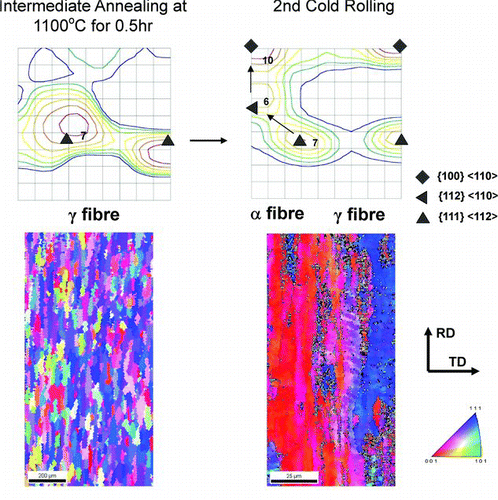Abstract
The recrystallization behavior of 12Cr and 15Cr oxide dispersion-strengthened (ODS) ferritic steels, which are the promising candidate materials for long-life core materials of the advanced fast breeder reactors, was investigated in terms of an intermediate softening heat treatment. It was clarified that keeping recovery structure at the intermediate heat treatment is indispensable for producing recrystallized structure at the final heat treatment. Prevention of repeating recrystallization is owing to the stable {100} 〈110〉 texture formation with less stored strain energy by the cold-rolling of the recrystallized structure. The two-step softening process was proposed to suppress the recrystallization and obtain adequate hardness reduction at the intermediate heat treatment. This process is effective for producing a stable recrystallized structure at the final heat treatment of the manufacturing process of ODS ferritic steel cladding.
1. Introduction
As a prospective cladding material for the long-life fuel element of the advanced fast breeder reactor, oxide dispersion-strengthened (ODS) ferritic steels are being developed by the Japan Atomic Energy Agency (JAEA) [Citation1,Citation2]. In order to overcome the poor workability, low ductility, and inferior high-temperature strength in the hoop direction of the manufactured 12Cr ODS ferritic steel cladding containing fine grains, recrystallization technique for the elongated grains along the rolling direction [Citation3] is applied to make coarser and equi-axial grains for the final cladding products. It was demonstrated that such recrystallized grains significantly improved the ductility and high-temperature strength in the hoop direction [Citation4,Citation5]. For a mass production of 12Cr ODS ferritic steel claddings, however, there are still difficulties in producing stable recrystallized grains at the final heat treatment. In this study, the recrystallization behavior of 12Cr and 15Cr ODS ferritic steels is investigated in terms of parameters at the intermediate heat treatment to clarify the cause of less repeatability of recrystallization, and an alternate manufacturing process is considered on the basis of the recrystallization mechanism of 12Cr and 15Cr ODS ferritic steels.
2. Experimental procedure
2.1. Cladding manufacturing process
The manufacturing process of 12Cr and 15Cr ODS ferritic steel cladding is schematically represented in . The mixture of Fe, Cr, C, W, and Ti element powders, yttria (Y2O3) powder, iron–yttrium intermetallic compound (Fe2Y) powder, and iron oxide (Fe2O3) powder were mechanically alloyed in a 10-kg attrition-type ball mill with a rotating speed of 220 revolutions per minute for 48 hours in argon gas atmosphere. Fe2Y and Fe2O3 powders were added with the aim of adjusting the oxygen content in the mechanically alloyed powders. The resulting mechanically alloyed powders were sealed in cans and degassed at 400°C in a vacuum of 0.1 Pa and then these powders were hot extruded at 1150°C and air-cooled to consolidate into bars of dimensions 18-mm outer width and 300-mm length. It was shown in the previous study that the oxide particles in a diameter of approximately 3 nm are dispersed in the extruded bar. After making a hole into the bar by a gun-drill, the cold-rolling by pilger mill is usually repeated four times to manufacture the final cladding in the dimensions of 6.9-mm outer diameter, 0.4-mm thickness, and 2000-mm length. The reduction ratio by pilger mill is always 45–50% for each pass. The cold-rolled cladding is annealed through the intermediate heat treatment after every step of cold-rolling in order to soften the work-hardened cladding. The typical increase in hardness during cold-rolling and intermediate heat treatment is shown in . In these processes, there are two key factors: keeping hardness less than Hv400 for the next cold-rolling and producing the recrystallized structure at the final heat treatment for the cladding products.
2.2. Test specimens
The chemical compositions of test specimens are shown in . Tube specimens of 12Cr ODS ferritic steel were cut from the cladding that was cold-rolled two times and were subjected to the intermediate heat treatment test. A plate specimen of 15Cr ODS ferritic steel of dimensions 12 mm × 15 mm × 20 mm was cut from the extruded bar, and cold–rolling was conducted at the reduction rate of 88% in parallel to the extrusion direction. Then, the cold-rolled plate was cut into small specimens for the isothermal annealing test at various temperatures.
Table 1 Chemical composition of test specimens (mass%)
2.3. Intermediate heat treatment tests using tube specimens
The intermediate heat treatment tests were conducted by using the secondary cold-rolled tube specimens. Two types of different process were selected after the second cold-rolling, which are shown in Figure . In “Intermediate Recovery” process, the secondary cold-rolled tubes were annealed at 1100°C through the second intermediate heat treatment, and again annealed at 1050°C after the third cold-rolling, where the recovery condition was maintained without recrystallization. The final heat treatment was given at 1150°C [Citation6]. On the other hand, “Intermediate Recrystallization” process leads to recrystallization at the second intermediate heat treatment by annealing at 1150°C and the third intermediate heat treatment was skipped to accumulate the cold-rolled strain. The final heat treatment was conducted at the same temperature of 1150°C as that of “Intermediate Recovery” process. Optical microstructure observations and hardness measurements (Hv10) in the longitudinal directions were made after each heat treatment in order to assess the amount of work hardening or softening and the grain morphology changes. The crystallographic orientation and texture analyses were carried out in a longitudinal cross-section of the tubes by using electron backscatter diffraction (EBSD).
2.4. Cold-rolling and two-step softening heat treatment tests using plate specimens
The cold-rolled texture was analyzed for two specimens of 15Cr ODS ferritic steels; one is just 70% cold-rolled plate specimen and the other is 70% cold-rolled one for the recrystallized specimen by annealing at 1100°C for 0.5 hours.
The 88% cold-rolled plate specimens of 15Cr ODS ferritic steel were annealed by one-step heat treatment and two-step heat treatment. The one-step heat treatment involved annealing at 1000°C for 24 hours or 1300°C for 1 hour, whereas the two-step heat treatment involved a first annealing at 900°C for 2 hours, followed by a second annealing at 1000°C for 24 hours or 1300°C for 1 hour.
3. Results
3.1. Optical microstructure and hardness
Figure shows the hardness at each heat treatment and the final microstructure in the intermediate heat treatment tests. In “Intermediate Recovery” process, the coarser recrystallized grains are uniformly formed with a hardness of about Hv300 at the final heat treatment of 1150°C. Each recovered structures gives hardness under Hv400. On the other hand, recrystallization happened at the second heat treatment in “Intermediate Recrystallization” process. This process cannot lead to the recrystallized grain structure and the finely elongated grains are kept at the same final heat treatment of 1150°C. This finding implies that the recrystallized grain structure cannot be easily repeated at the final heat treatment once recrystallization occurs at the intermediate heat treatment in the course of cladding manufacturing.
3.2. Crystalline orientations analyses
An orientation image map (OIM) of 12Cr ODS ferritic steel tube specimen at each heat treatment is represented in . The OIM was taken in parallel to the rolling plane of the cladding. In “Intermediate Recovery” process, {100} in red color and {111} in blue color were formed in parallel with the rolling plane by the second heat treatment after the second cold-rolling. It is known that this texture has an orientation of 〈110〉 α-fiber along the rolling direction. The recovered specimen after third cold-rolling (48%), third intermediate recovery heat treatment (1050°C), and final cold-rolling (47%) induces mainly recrystallized texture of {110} 〈112〉 in green color and {111} 〈112〉 in blue color by the final heat treatment at 1150°C, where {110} 〈112〉 is a rotated orientation by 35.3° with a [110] axis from the {110} 〈001〉 Goss orientation. On the other hand, “Intermediate Recrystallization” process leads to the same recrystallized texture as the “Intermediate Recovery” process at the recrystallization heat treatment after the second cold-rolling. The texture at the final heat treatment at 1150°C after the third cold-rolling of 48%, skipping the third intermediate recovery heat treatment, and the final cold-rolling of 47% is dominated by the cold-rolled texture without recrystallization. The area of {100} 〈110〉 in red color is wider as compared with the cold-rolled texture after the second heat treatment in “Intermediate Recovery” process, as shown in Figure .
3.3. Cold-rolling test of recrystallized plate specimens
Orientation distribution function (ODF) of texture change by cold-rolling after hot extrusion is shown in . From the ODF, it is obvious that the red area corresponds to {100} 〈110〉 grains and blue {111} 〈112〉 grains. The other α-fiber textures with 〈110〉 orientation parallel to the rolling direction can be seen. In , the inverse pole figure (IPF) and ODF of texture change are shown for the recrystallized specimen by annealing at 1100°C as well as by the recrystallized then 70% cold-rolled specimen. Numerical values shown in the ODF map indicate how many times stronger than the random orientation. It is shown that the value of the cold-rolled plate is 4, while that of the cold-rolled recrystallized plate increases to 10 for {100} 〈110〉 in red color. Thus, cold-rolling of the recrystallized specimen leads to the strong {100} 〈110〉 texture formation, which is consistent with Figure .
3.4. Two-step softening heat treatment test of plate specimen of 15Cr ODS ferritic steels
This test is based on Buruke's study that demonstrated an increase in the recrystallization temperature with decreasing the cold-rolled level [Citation7]. A comparison of the results of one- step and two-step softening heat treatment tests are shown in . Coarser oxide particles in a type of YAlO3, which was formed in 15Cr ODS ferritic steel by addition of aluminum, lead to falling of the recrystallization temperature (1000°C) from that of 12Cr ODS ferritic steel (1150°C), which contains Y2Ti2O7 type of oxide particles. In one-step heat treatment, the recrystallized grains with {110} 〈112〉 texture were produced by annealing at 1000°C for 24 hours, and {111} 〈112〉 and {110} 〈112〉 textures were produced by annealing at 1300°C for 1 hour.
On the contrary, in two-step annealing, the specimen was at first annealed at 900°C for 2 hours, through which the recovered condition was kept with the same microstructure as the cold-rolled state. Then, the specimen was again annealed at 1000°C for 24 hours but the recrystallized structure was not produced. By increasing the annealing temperature to 1300°C for 1 hour, the recrystallized structure with coarse {110} 〈112〉 texture was produced, which is the same structure as that formed at 1000°C in one-step annealing. These results of the tests imply that recrystallization is retarded by recovery annealing before final annealing.
4. Discussion
Based on the results of the cold-rolling test of plate specimens, it was clarified that cold-rolling of the recrystallized texture produces a strong texture of {100} 〈110〉 orientation. shows the processing route of {100} 〈110〉 orientation by crystalline rotation during cold-rolling in 15Cr ODS ferritic steel. It is known from the typical crystalline rotation during cold-rolling in conventional 3% silicon steel [Citation8] that the {111} 〈112〉 recrystallized texture rotates and finally attains the {100} 〈110〉 texture via the {112} 〈111〉 texture. However, based on the ODF analysis in this study, it was shown that the {111} 〈112〉 recrystallized texture rotates to {100} 〈110〉 as the final stable orientation through {111} 〈110〉 to {112} 〈110〉.
Figure 8 Processing route of the {100} 〈110〉 orientation by crystalline rotation during cold-rolling in 15Cr ODS ferritic steel
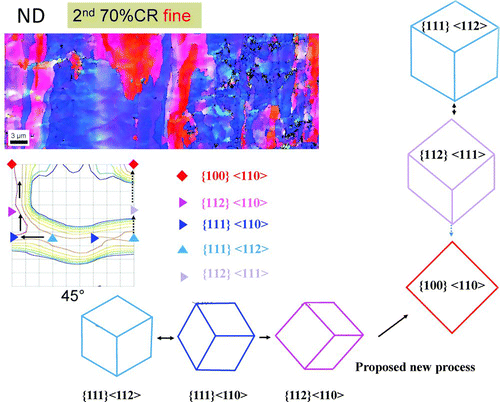
An isothermal recrystallization curve of 3.25% silicon steel at 700°C is represented in [Citation9]. It is obvious that the {100} 〈110〉 texture cannot be recrystallized and made completely stable even for longer heating time, which is owing to the extremely low strain energy accumulated during cold-rolling for the {100} 〈110〉 crystalline orientation. This behavior is ascribed to the fact that the {110} 〈111〉 slip system in BCC metal is symmetrical with the {100} 〈110〉 orientation. Considering that the driving force for recrystallization is the strain energy stored in the cold-rolled specimen's surrounding matrix, a lower driving force for recrystallization of the cold-rolled {100} 〈110〉 texture retards the recrystallization. Easy formation of the {100} 〈110〉 texture by cold-rolling of the recrystallized texture results in the difficulty in repeating recrystallization. This finding clearly interprets the results of the intermediate recrystallization tests shown in Figure that the recrystallizaton cannot be repeated for the cold-rolled structure of the recrystallized texture.
Figure 9 Isothermal recrystallization curve of 3.25% silicon steel at 700°C [Citation9]
![Figure 9 Isothermal recrystallization curve of 3.25% silicon steel at 700°C [Citation9]](/cms/asset/b07d641e-fca5-47a0-9cff-3d967a504b0f/tnst_a_772446_o_f0009g.gif)
Figure demonstrates that adequate structural recovery at the first heat treatment causes retardation of the recrystallization at the second heat treatment. This is due to the release of the stored strain energy at the first heat treatment, which reduces the driving force for the recrystallization at the second heat treatment [Citation10]. This result suggests that the adequate softening of the cold-rolled structure can be attained without recrystallization by higher-temperature annealing at the second heat treatment. In the cladding manufacturing process, intermediate annealing is indispensable after cold-rolling to reduce the hardness, and recrystallization should be avoided to reach the recrystallized structure at the final heat treatment of the manufactured cladding. The two-step softening heat treatment at the intermediate annealing, proposed in this study, is an effective approach for the stable manufacturing process of ODS ferritic steel cladding.
5. Conclusion
The following results were obtained in this study:
| 1. | The intermediate recrystallization should be avoided to form the recrystallized structure at the final heat treatment of the manufacturing process of ODS ferritic steel cladding. This is owing to the production of the unique texture of {100} 〈110〉 by cold-rolling of the recrystallized structure. The {100} 〈110〉 texture retards recrystallization due to less stored energy, and new formation process of the {100} 〈110〉 texture has been proposed by considering the crystalline rotation. | ||||
| 2. | Two-step softening heat treatment reduces the driving force for recrystallization by structural recovery and thus increases the recrystallization temperature. This process is effective for producing a stable recrystallized structure in the manufacturing process of ODS ferritic steel cladding. | ||||
References
- Ukai , S , Mizuta , S , Fujiwara , M , Okuda , T and Kobayashi , T . 2002 . Development of 9Cr-ODS martensitic steel claddings for fuel pins by means of ferrite to austenite phase transformation . J Nucl Sci Technol , 39 : 778 – 788 . doi: 10.1080/18811248.2002.9715260
- Ukai , S , Kaito , T , Ohtsuka , S , Narita , T , Fujiwara , M and Kobayashi , T . 2003 . Production and properties of nano-scale oxide dispersion strengthened (ODS) 9Cr martensitic steel claddings . ISIJ Int , 43 : 2038 – 2045 . doi: 10.2355/isijinternational.43.2038
- Ukai , S , Harada , M , Okada , H , Inoue , M , Nomura , S , Shikakura , S , Nishida , T , Fujiwara , M and Asabe , K . 1993 . Tube manufacturing and mechanical properties of oxide dispersion strengthened ferritic steel . J Nucl Mater , 204 : 74 doi: 10.1016/0022-3115(93)90201-9
- Narita , T , Ukai , S , Kaito , T , Ohtsuka , S and Kobayashi , T . 2004 . Development of two-step softening heat treatment for manufacturing 12Cr-ODS ferritic steel tubes . J Nucl Sci Technol , 41 : 1008 – 1012 . doi: 10.1080/18811248.2004.9726324
- Ukai , S , Nishida , T , Okada , H , Okuda , T , Fujiwara , M and Asabe , K . 1997 . Development of oxide dispersion strengthened ferritic steels for FBR core application (I): improvement of mechanical properties by recrystallization processing . J Nucl Sci Technol , 34 : 256 doi: 10.1080/18811248.1997.9733658
- Mizuta , S and Fujiwara , M . 2001 . JNC report no. TN9400 , 103 Ibaraki , , Japan : Japan Nuclear Cycle Development Institute . in Japanese
- Burke , J E and Turnbull , D . 1952 . Recrystallization and grain growth . Prog Metal Phys , 3 : 220 doi: 10.1016/0502-8205(52)90009-9
- Taoka , T , Furubayashi , E and Takeuchi , S . 1968 . Formation of cold-rolled texture and recrystallized texture in single crystals of 3% silicon iron . Tetsu to Hagane , 54 : 162 – 210 . [in Japanese]
- Hibbard , W R and Tully , W R . 1961 . The effect of orientation on the recrystallization kinetics of cold-rolled single crystals . Trans. AIME , 221 : 336 – 343 .
- Leng , B , Ukai , S , Sugino , Y , Tang , Q , Narita , T , Hayashi , S , Wan , F , Ohtsuka , S and Kaito , T . 2011 . Recrystallization texture of cold-rolled oxide dispersion strengthened ferritic steel . ISIJ Int , 51 : 951 – 957 . doi: 10.2355/isijinternational.51.951
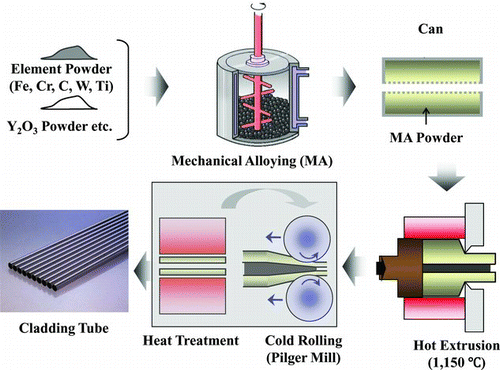

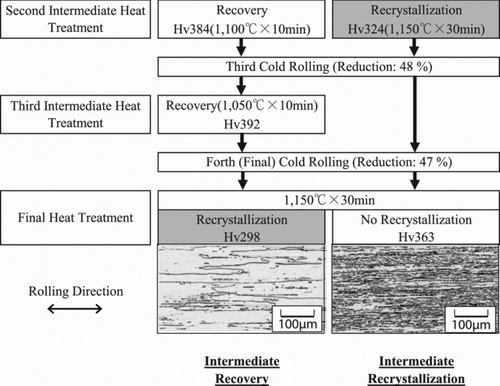
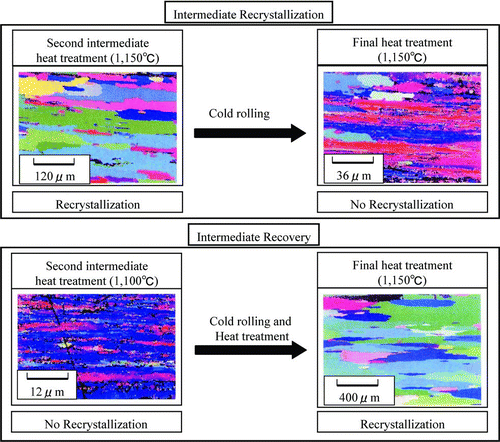
![Figure 5 Texture change by the first 70% cold-rolling after hot extrusion [ϕ2 = 45° section of ODF (orientation distribution function)]](/cms/asset/ed0e6e12-348d-4784-bba8-6a718ca6c189/tnst_a_772446_o_f0005g.jpg)
